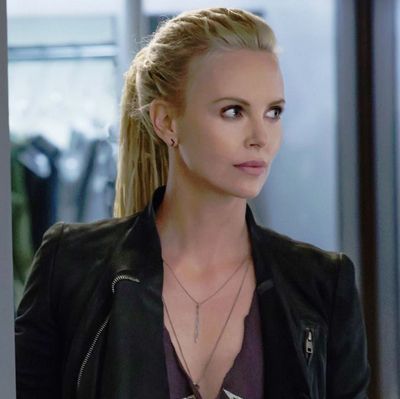
I have a very important and pressing question that only Charlize Theron’s Fate of the Furious character can answer. Where does one, while flying thousands of miles in the air in a stealthy evil airplane lair, get their 18-inch mini-locs re-twisted?
I was pondering that hair because Fate doesn’t give Theron much else to do, as far as masterminding goes. She talks in circles about choice theory and accountability, makes out with Dom Toretto in front of his beloved Letty, and then barks commands to a nuclear submarine. Otherwise — and the actress has even admitted this — Theron’s supervillain hacker Cipher just sits around a lot, serving up the occasional scowl when it suits her.
The dreads, then, are a quick and appropriative way to add some dimension to her character. (Director F. Gary Gray told Vulture they were Theron’s idea.) Those mini-locs chew up more scenery than any other man, woman, or automobile in this movie. Just when you think, This can’t be happening, or Charlize, girl, really?, there they are again, braided up or gathered in a high ponytail. Fate of the Furious commits to a lot of things — that’s always been this franchise’s charm — but it really commits to the locs.
A little bit of outrage to get out of the way, for the sake of housekeeping. Haven’t we, as a culture, moved beyond white dreadlocs? Shouldn’t we know by now? White locs are the ultimate self-own: Your hair will break off. Then there’s the underlying subtext of white dreads, that they usurp Rasta culture, and expose a double standard: Black women are penalized for our dreadlocks; white women get to use them to add an extra bad-girl dimension to the characters they play in blockbuster movies. So, yeah. No more white-lady dreadlocks.
But back to Cipher and her loc maintenance. As one car chase turned into another, my mind kept returning to all the outrageous methods Cipher could be using to tend to her culturally appropriated tresses. YouTube is a mecca for black women sharing hair-care tips — whose videos is she watching? Cipher didn’t always have these locs. Her government watch list profile shows her with Theron’s usual close crop. In fact, her whole look is different: less goth Free People chic, more Actual Adult Villain HBIC. In that same scene, Kurt Russell’s Mr. Nobody reveals Cipher spent some time in Greece. Maybe she picked up the dreads there? She wouldn’t be the first white woman to return from an overseas jaunt with some ill-advised locs.
To make matters even more farcical, Cipher’s diverse team of millennial hackers includes a black man who also has locs — the movie’s way of saying that at least some people know how dreads should be worn. How many times a day do you think that guy has to dodge his boss’s manicured nails from picking at his scalp? How many microagressions does that man experience before lunch? Does she ask him how his hair grows that way at a company meeting, in front of everyone? When she runs out of jojoba oil or shea butter, does she launch a secret mission to break into his private quarters and snatch some?
In our current Boss Baby world, it’s very easy to see art made well before the election as some kind of Trumpian commentary. But maybe these dreads are Charlize and director F. Gary Gray’s attempt at some subtle racial commentary: a series that lets a bunch of nonwhite actors do awesome stunts was bound to attract a wacky Rachel Dolezal character eventually. If Cipher can’t have clear motivations or a discernible arc, at least she’s got a fascinating, ahem, twist.


